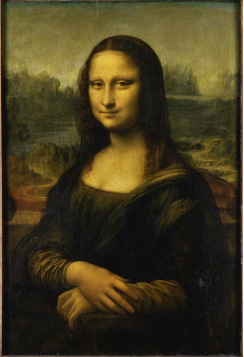Mona Lisa is a famous masterpiece painted by Leonardo da Vinci in the sixteenth century (see Figure 1). Even though there is no conclusive evidence, it is generally accepted that da Vinci began working on the painting in 1503 and finished it in 1516 (Mehra & Campbell, 2018). The painting belongs to renaissance art, which emerged in the 1400s and signified a gradual change in values from medieval art (Oxford Art Online, n.d.).
The period is associated with a rise of interest in humanistic learning, individualism, and nature (Oxford Art Online, n.d.). Moreover, Ball (2017) suggests that Renaissance artists aimed at making metaphysical statements. While Mona Lisa is a portrait, which does not seem to have any metaphysics connected with it due to its realism, it is not the case (Mehra & Campbell, 2018). Da Vinci is unique in the movement since he aimed at fusing art and science to address metaphysical matters (Ball, 2017). Ball (2017) explains that Mona Lisa is a fusion of microcosm to macrocosm. In other words, there is an analogy between the earth and the body, which da Vinci’s innovation (Ball, 2017). Therefore, Mona Lisa is not a traditional Renaissance painting, but it still has distinctive features of the period.

In the creation of his masterpiece, da Vinci was influenced by different historical events and trends in art, which can be seen in the painting. On the one hand, Europe became open to knowledge from the east, which led to the increased spreading of mathematics. According to Ball (2017), Leonardo da Vinci studied geometric optics, which made allowed him to depict Lisa Gherardini with great realism. Da Vinci’s background as a scientist made him implement his knowledge of art to approach the classical themes from another angle.
On the other hand, the artists still preferred for his content to be metaphysical, which is an obvious influence of the Renaissance. According to Ball (2017), “the cascading fabric of [Mona Lisa’s] dress reflects Leonardo’s idea of universal flow forms” (para. 6). At the same time, the interest in nature and humanistic learning are also present since there is a parallel between her hair and the flow of water (Ball, 2017). In other words, while the painting is unique and da Vinci’s style is exceptional, his works are influenced by historical events, science, and themes common to the period.
The research about Mona Lisa increased my appreciation in two ways. First, it allowed understanding the background and the hidden meaning of the painting. Second, the research uncovered the unique characteristics of da Vinci’s style, which were innovative for the period in the history of art. Knowing that Mona Lisa belongs to Renaissance, which tended to touch upon metaphysics, helps to understand that the painting is more than just a portrait. The context helps to realize that the painting is a reflection of the world at large.
References
Ball, P. (2017). Art: Under Mona Lisa’s smile. Nature, 546(7656), 32.
Mehra, M. R., & Campbell, H. R. (2018). The Mona Lisa decrypted: Allure of an imperfect reality. Mayo Clinic Proceedings, 93(9), 1325-1327).
Oxford Art Online. (n.d.). Renaissance art and architecture. Web.